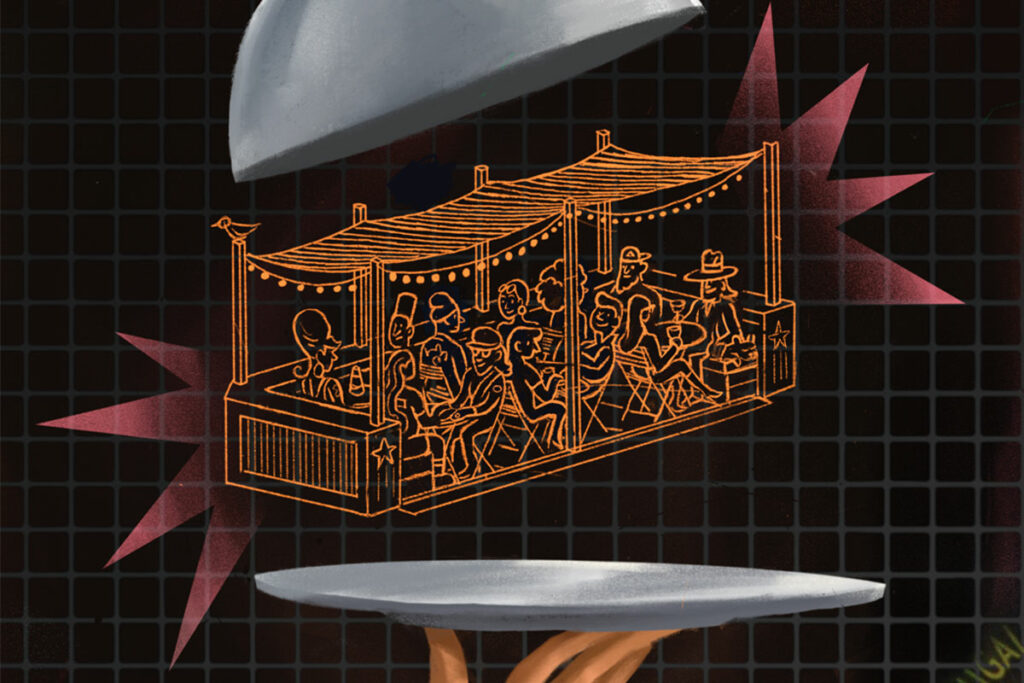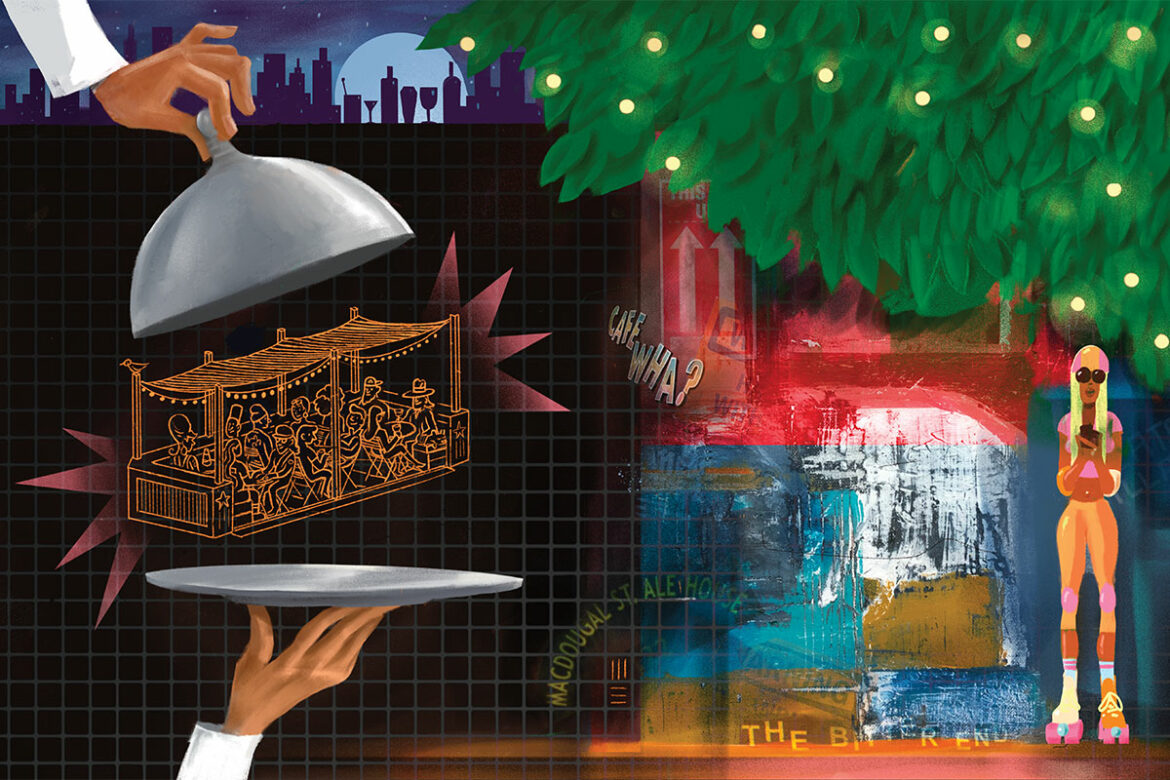URBAN DESIGN + DINING SHEDS
The challenges of outdoor dining
Turn most corners in New York City and you’re bound to encounter diners relaxing over cocktails and a meal in the road. It’s a scene that represents, to many, an exciting way to use New York City’s streets. Andrew Dolkart sees it differently; he’s a historian and preservationist who teaches at Columbia University’s Graduate School of Architecture, Planning and Preservation.
“We are now experiencing the visuals of the cityscape in a completely different way,” he says with concern. “You can’t see buildings anymore because they’re hidden by these.”
“These” are the dining sheds that took over streets, loading zones, and parking spots across New York City when then Mayor DiBlasio launched Open Restaurants in June 2020, three months after COVID’s onset. The program allowed restaurants to serve food in the streets more safely than it could be served indoors. Almost overnight, dining sheds appeared—lifelines to restaurants that, even before the pandemic, were being decimated by soaring real estate costs.“ Now, of course, most of them are so deteriorated that they’re eyesores,” Dolkart says.
Many restaurateurs saw the ad-hoc structures as a positive addition to the streetscape. Tren’ness Woods-Black of Sylvia’s in Harlem says the sheds brightened the neighborhood surrounding Sylvia’s and that they “showed how restaurants lend themselves not only to being part of the commercial landscape, but the beautification landscape.”
In Bed-Stuy, Charlotta Janssen of Chez Oskar had long been fighting for the right to serve outside. When COVID made that possible, Janssen, like many other restaurateurs, experimented with different setups, including tents and umbrellas (which, she says, “are accidents waiting to happen”). Eventually Janssen crafted weather-resistant canopies from plastic and steel, wave-like structures inspired by Hector Guimard’s Art Nouveau Metro entrances. For Janssen, the sidewalk was a place for expression.
Open Restaurants also brought equity. Prior to the pandemic, licenses for sidewalk seating could be purchased, but the fees were high and the process to obtain them, laborious. Restaurants that offered sidewalk seating were a moneyed group almost entirely located in Manhattan. But COVID-era regulations meant that restaurants previously excluded from the sidewalk seating club—for both zoning and financial reasons—could get in the door.
“I think it [Open Restaurants] uncovered the outdatedness of some of our zoning,” says Gabriel Stulman, CEO and founder of Happy Cooking Hospitality, whose quartet of West Village restaurants includes Jeffrey’s Grocery.
This year, dining sheds are getting a NYC-mandated makeover. Dining Out NYC, a program launched in February 2024, makes outdoor dining a permanent feature in New York City. It seeks to address some of the complaints that the first wave sheds drew—namely, that they became decrepit and/or dangerous, and that they attracted trash, vandalism, and vermin. The plan addresses both curbside dining and sidewalk cafés and imposes stricter regulations for the construction of dining structures, including detailed materials and composition specs (also, gone are the days of fully enclosed dining sheds). Furthermore, the new plan outlines ADA accessibility requirements, a simpler application process, and generally lower permit fees that vary per borough, size of structure, and permit type. Restaurants must either apply for the new permits or remove their outdoor structures by August 3, 2024.
The new rules will make unique designs like Janssen’s an impossibility. And, because only four structure designs are permitted under Dining Out NYC, our current streetscape will be affected. As Dolkart notes, “The dining sheds may become rather homogeneous to comply with the rules.”
For Janssen, the prospect of removing her canopies is devastating. But to keep her structure (which is affixed to the building), Chez Oskar will need special approval from the City. It would be a lengthy and likely expensive process—and given that Chez Oscar is in a landmarked building, Janssen’s not optimistic. While Dolkart acknowledges that some restaurateurs are “doing something fun or interesting” with their sheds, architectural additions like Janssen’s are the kind of structures that make preservationists uncomfortable.
“Preservationists in general are opposed to these because they have a negative impact on historic neighborhoods,” Dolkart notes. Those impacts include damaging historic facades or blocking historic buildings from view.
“I give a lot of walking tours and I used to say, ‘You need to stand on the other side of the street to really appreciate the building,’” Dolkart says. “But now you stand on the other side of the street in places like MacDougal Street on the block just north of Washington Square where there are all these great 19th-century houses that you just can’t see anymore.”

The new plan stipulates that the sheds can only operate between April and November, after which they must be dismantled and stored over the winter. Dolkart notes that removing storing, and re-erecting the structures will encourage the annual maintenance that’ll prevent them from becoming eyesores, but those requirements raise concerns about cost; the expense of dismantling, carting, and storing the structures will be prohibitive for some businesses. Ya-Ting Liu, chief public realm officer at the Office of the Mayor, hopes that a competitive marketplace will lower costs, but Janssen says that, right now, those costs are too high. She’s heard from fellow restaurateurs who may give up their outdoor spaces altogether.
“That’s an issue,” Dolkart notes. “Who’s going to be able to afford them?” While Open Restaurants leveled the outdoor dining playing field, Dolkart argues that only successful restaurants in wealthy neighborhoods might profit under Dining Out NYC.
Since they first appeared, the sheds have sparked an argument about the privatization of City streets. They occupy public land, yet don’t pay real estate tax, and—until Dining Out NYC recently banned it—covered parking spaces that would otherwise generate City revenue via Muni Meters and parking fines. Then there’s the fact that the dining sheds occupy public thoroughfares to benefit for-profit businesses. As Dolkart notes, “It’s a taking of the public space.”
Four years in, the conversation about dining sheds continues, though it’s no longer about COVID: Under Dining Out NYC, the structures will be absent during COVID’s annual mid-winter peak in infection rates. Instead, those pandemic-born structures have become a way for independent neighborhood restaurants to survive amid post-COVID inflation and escalating payroll and real estate costs. They address the risk that—if small, independent restaurants can’t eke out profits—our streetscapes could fill with empty storefronts and the logos of corporate chain restaurants. It will take time to balance the needs of neighborhood restaurants and our duty to preserve New York’s streetscapes, but, as Stulman warns, “We can’t make perfection the enemy of progress.”
Outside Jams
PRESENTED BY BETHEL WOODS CENTER FOR THE ARTS
THE OUTLAW MUSIC FESTIVAL
Willie Nelson played with his family and friends at Bethel Woods Center for the Arts on Saturday, July 6th. Enjoy some tunes from the tour by Willie Nelson & Family, Bob Dylan, Robert Plant & Alison Krauss, Celisse, and more.
Check out upcoming events at Bethel Woods Center for the Arts.



